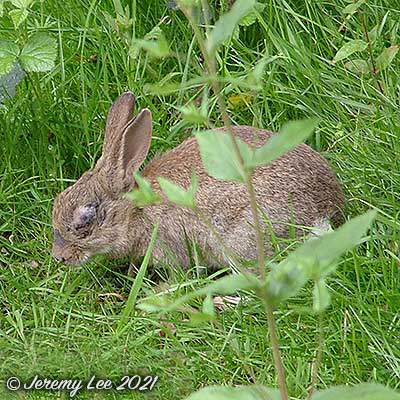
 |
|
Scientific Classifications explained » Amphibians » Ants » Aphids » Bees » Beetles » Birds » Bugs » Butterflies » Caterpillars » Damselflies » Dragonflies » Earwigs » Flies » Frog/Leafhoppers » Fungi » Galls » Grasshoppers » Harvestmen » Hoverflies » Lacewings » Ladybirds » Leaf Mines » Lichens » Mammals » Millipedes » Mosses » Moths » Sawflies » Slugs » Snails » Spiders » Trees & Shrubs » Wasps » Wild Flowers » Woodlice » Postboxes |
UK Nature > Mammals > Oryctolagus cuniculus

Scientific Name: Oryctolagus cuniculus Common Name: European Rabbit Oryctolagus cuniculus, otherwise known as the European Rabbit, have brown-grey fur, pale bellies and long ears (but these are relatively short compared with those of a hare). The underside of the tail is white – this can be seen as the rabbit runs away from danger, and acts as a warning to others nearby. Rabbits are not native to Britain; the Normans brought them here in the 12th century for their then much-prized fur and meat. Today, rabbits are among our commonest and most widespread mammals. They live in a system of burrows called a warren. They use regular trails between their burrows and feeding areas, which often become worn and conspicuous. You may see a pile of rabbit droppings in a prominent place – this is a communal latrine also used as a territory marker. Rabbits are prolific breeders and populations can quickly increase in the right conditions. Diet consists of leaves and shoots of a range of vegetation, including crops. In winter, grass, bulbs and bark. As their diet is hard to digest, rabbits eat their food twice. After eating they produce soft droppings that still have high nutritional value; they eat these, and then produce hard pellets of waste material. Can be seen at any time of the year, more often at dusk, night-time and early morning; can be seen on heaths, grassland, meadows, woodland and sometimes in suburban gardens. |
|

https://www.uknature.co.uk is a website dedicated to showing the immense diversity of UK nature and wildlife. Our vast range of habitats, from lowland arable to snow covered mountains, from storm-ravaged coastlines to peaceful inland freshwater lakes and rivers, from dry, sandy heaths to deciduous and coniferous forests, all these habitats contribute to the abundance of UK nature. We have wild birds in huge numbers either residing or visiting our shores (597 recorded species as at July 2013) and we must also not forget the humble back garden with its grass lawns, flower beds filled with nectar rich flowers, shrubs and trees, all designed to attract huge numbers of insects such as bees, moths, butterflies and hoverflies; and finally the small ponds which provide safe havens for frogs, toads, newts and even slow worms and grass snakes. www.uknature.co.uk is the showcase for my personal passion, photographing uknature in all its glory. I sincerely hope you all enjoy the fruits of my labours. This site and all images contained therein is © Jeremy Lee 2004 - 2025. All Rights Reserved. Site design by Jeremy Lee. Site development & IT Support by Stuart Lee. |